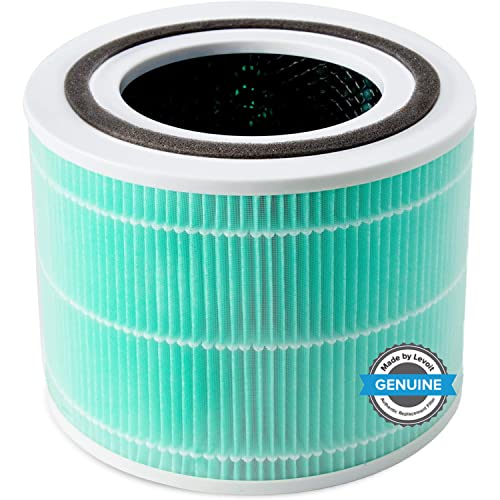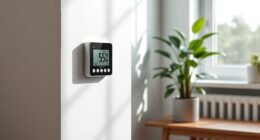As an Afloia air purifier owner, I got stumped by a red light that just wouldn’t quit blinking. Here, we’ll dive into what’s really going on with that mysterious flashing and arm you with some handy tips to fix it.
By understanding the error codes and following the tips for prevention and maintenance, we can keep our air purifiers functioning optimally.
Let’s explore why our Afloia air purifiers might be blinking red and how to address this issue effectively.
Key Takeaways
- Possible causes of the red blinking light on an Afloia Air Purifier include a clogged filter, filter problem (indicated by error code E1), motor malfunction (error code E2), or an issue with the air quality sensor (error code E3).
- Troubleshooting steps for the red blinking light include checking error codes, consulting the user manual, following provided troubleshooting steps, resetting the purifier, and cleaning or replacing filters.
- Resetting the air purifier involves turning it off and unplugging, removing the front cover, pressing and holding the reset button, releasing and waiting, and plugging in and turning on.
- Regular maintenance, such as cleaning and replacing filters, is important to prevent the red blinking light and ensure optimal performance of the Afloia Air Purifier.
Possible Causes of Red Blinking Light
One possible cause for the red blinking light on your afloia air purifier is a clogged filter. When the filter becomes clogged with dust, pet dander, or other particles, it restricts the airflow and puts a strain on the purifier’s motor. This can trigger the red blinking light as a safety measure.
To troubleshoot this issue, first, turn off the purifier and unplug it from the power source. Then, carefully remove the filter and inspect it for any visible buildup. If it is dirty or clogged, gently clean or replace it according to the manufacturer’s instructions.
After cleaning or replacing the filter, plug in the purifier and turn it on. If the red blinking light persists, there may be other potential causes that need further investigation.
Understanding the Error Codes
The error codes on the afloia air purifier can help you understand why it is blinking red. Understanding these error indicators is crucial for troubleshooting the issue effectively.
Here are the key error codes and their meanings:
-
E1: This code indicates a problem with the filter. Check if the filter is dirty or not properly installed, and clean or replace it if necessary.
-
E2: This code signals a malfunction in the motor. Ensure that the motor is not blocked or damaged, and contact customer support if needed.
-
E3: This code suggests an issue with the air quality sensor. Clean the sensor with a soft cloth and ensure it is not obstructed.
Troubleshooting Steps for Red Blinking Light
To troubleshoot the red blinking light, you should first check the error codes on your afloia air purifier. The red light indicates that there is an issue with the purifier that needs to be addressed.
To begin, consult the user manual for a list of error codes and their meanings. Each error code corresponds to a specific problem, such as a filter replacement or a malfunctioning sensor. Once you have identified the error code, follow the troubleshooting steps provided in the manual.
These steps may include resetting the purifier, cleaning the filters, or contacting customer support for further assistance. It is important to address the issue promptly to ensure optimal performance of your afloia air purifier.
In the following section, we will discuss common issues with afloia air purifiers and how to resolve them.
Common Issues With Afloia Air Purifier
When experiencing problems with your afloia air purifier, it’s essential to identify the specific issue and take appropriate action. Here are some common issues you may encounter with your afloia air purifier:
-
Air purifier noise troubleshooting:
-
Check for loose or damaged parts and tighten or replace them accordingly.
-
Clean the air intake vents and remove any obstructions.
-
Ensure the air purifier is placed on a level surface to prevent vibrations.
-
Cleaning air purifier filters:
-
Refer to the user manual for specific instructions on how to remove and clean the filters.
-
Use a soft brush or vacuum cleaner to remove dust and debris from the filters.
-
Rinse the filters with water if they are washable, and allow them to dry completely before reinstalling.
How to Reset the Air Purifier
In this discussion, I will explain the steps to reset your air purifier, troubleshoot blinking lights, and restore the factory settings.
Resetting the air purifier can help resolve issues such as malfunctioning sensors or error messages.
Troubleshooting blinking lights will help identify the specific problem and find a suitable solution.
Lastly, restoring the factory settings can be a useful option if all other troubleshooting steps fail to resolve the issue.
Resetting Air Purifier Steps
You can easily reset your afloia air purifier by following these steps:
-
Turn off the air purifier and unplug it from the power source.
-
Remove the front cover of the air purifier by gently pulling it away.
-
Locate the reset button on the control panel of the air purifier. It is usually labeled as ‘Reset’ or represented by a small circular arrow.
-
Press and hold the reset button for about 5 seconds.
-
Release the reset button and wait for a few seconds.
-
Plug the air purifier back into the power source.
-
Turn on the air purifier and check if the blinking red light issue has been resolved.
Resetting your air purifier is a simple process that can help resolve various issues, including a blinking red light. However, if the problem persists, it may indicate a more serious issue, such as the need for cleaning filters or replacing the air purifier altogether.
Troubleshooting Blinking Lights
To troubleshoot the issue with the blinking lights, try resetting the air purifier by following the steps mentioned earlier.
If the blinking lights persist, it may indicate a power issue or an error message that needs to be addressed.
First, check the power source and ensure the air purifier is properly plugged in. If the power source is fine, refer to the user manual to understand the error messages associated with the blinking lights.
These error messages can provide valuable information about the specific issue at hand. It could be a filter replacement reminder, a sensor malfunction, or a problem with the internal components.
Restoring Factory Settings
If the factory settings need to be restored on your Afloia air purifier, follow the steps mentioned earlier to reset it. Restoring the factory settings can help resolve any issues or error codes you may be experiencing with your device. Here’s a troubleshooting guide to help you through the process:
- Power off the air purifier and unplug it from the power source.
- Locate the reset button on the control panel.
- Use a small tool, like a paperclip, to press and hold the reset button.
- While holding the reset button, plug the air purifier back into the power source.
- Continue to hold the reset button for about 10 seconds.
- Release the reset button and wait for the air purifier to restart.
The air purifier will now be restored to its factory settings, and any error codes should be cleared.
Tips to Prevent Red Blinking Light
One way to prevent the red blinking light on your Afloia air purifier is by cleaning the filter regularly. The filter is responsible for trapping dust, allergens, and other particles, and when it becomes clogged, it can cause the air purifier to malfunction. To ensure proper functioning, it is important to follow these maintenance tips:
| Maintenance Tips | Frequency |
|---|---|
| Clean the filter | Every 2-3 months |
| Replace the filter | Every 6-12 months |
| Wipe the exterior | Weekly |
| Vacuum the vents | Monthly |
Importance of Regular Maintenance
Regular maintenance is crucial for keeping your air purifier in optimal condition and ensuring its effectiveness. Neglecting maintenance can lead to decreased performance and even potential health risks.
Here are some important reasons why regular maintenance, including filter replacement, is essential:
-
Preventing buildup: Over time, air purifier filters accumulate pollutants and particles, reducing their efficiency. Regularly replacing filters prevents the buildup of contaminants, ensuring clean and healthy air quality.
-
Maximizing effectiveness: Air purifiers with clean filters can effectively capture and remove airborne pollutants such as dust, pet dander, pollen, and allergens. Regular maintenance ensures that your air purifier operates at its highest efficiency, providing you with the best possible air quality.
-
Extending lifespan: Proper maintenance, including filter replacement, helps prolong the lifespan of your air purifier. By keeping the unit clean and functioning optimally, you can avoid costly repairs or the need for premature replacement.
Regular maintenance and filter replacement are essential for the long-term performance and effectiveness of your air purifier, ultimately benefiting your health and well-being.
Contacting Afloia Customer Support
When it comes to troubleshooting common issues with your Afloia air purifier, it’s essential to have a clear understanding of the warranty and return policy.
As a customer, I can rely on Afloia’s customer support team to guide me through the process of identifying and resolving any problems I may encounter. If necessary, they can provide instructions on how to return the product for repair or replacement under the warranty terms.
Troubleshooting Common Issues
If your Afloia air purifier is blinking red, it could be due to a common issue that can be easily troubleshooted. Here are a few steps you can take to resolve the problem:
-
Check the filters: Ensure that the filters are clean and properly installed. Dirty filters can hinder the airflow and trigger the red blinking light.
-
Reset the purifier: Try resetting the air purifier by unplugging it from the power source for a few minutes before plugging it back in. This can often resolve any temporary malfunctions.
-
Improve air quality: Consider the environment in which the air purifier is placed. Eliminate potential sources of pollution such as smoking or excessive dust. This can help the purifier operate more efficiently and reduce the likelihood of the red blinking light.
Warranty and Returns
To initiate a warranty claim or return, you can contact our customer service department. Our warranty claim process is designed to ensure that you receive the necessary support and resolution for your concerns.
If your Afloia air purifier is not functioning properly or is defective, we offer a warranty to cover any manufacturing defects or malfunctions.
Our return policy and procedure allow you to return the product within a specified period if you are not completely satisfied.
When contacting our customer service department, please provide us with the necessary information, such as your purchase details and a description of the issue. Our team will guide you through the warranty claim process or assist with your return, ensuring a smooth resolution.
Upgrading or Replacing Your Afloia Air Purifier
Upgrading or replacing your Afloia air purifier can be beneficial if you frequently encounter issues like a blinking red light. As a user, it is important to consider the available options to enhance the performance and effectiveness of your air purifier.
Here are a few reasons why upgrading or replacing your Afloia air purifier could be a good idea:
-
Upgrading features: Newer models often come with advanced features such as improved air filtration technology, increased coverage area, and smart functionalities like Wi-Fi connectivity and voice control.
-
Enhanced performance: Upgrading your air purifier can result in better air purification efficiency, ensuring that you breathe cleaner and healthier air.
-
Maintenance schedule: Newer models may offer improved maintenance options, such as filter replacement indicators and automatic cleaning cycles, making it easier to keep your air purifier in optimal condition.
Considering these factors, upgrading or replacing your Afloia air purifier can help resolve the blinking red light issue and provide you with a more efficient and convenient air purification experience.
Frequently Asked Questions
How Often Should I Clean or Replace the Filters in My Afloia Air Purifier?
I clean or replace the filters in my Afloia air purifier every 3 months. Regular maintenance ensures optimal performance and keeps the air in my small space clean and free from pollutants.
Can the Red Blinking Light Indicate Any Other Issues Besides a Filter Problem?
The red blinking light on my Afloia Air Purifier can indicate other possible causes besides a filter problem. To troubleshoot, check for a clogged air intake, a malfunctioning sensor, or a power issue.
Is It Normal for the Red Blinking Light to Stay on for a Long Period of Time?
Yes, it is normal for the red blinking light to stay on for a long period of time. This typically indicates a filter problem. To troubleshoot, try replacing the filter or contacting customer support for assistance. A prolonged red blinking light can impact the performance of the air purifier.
Can the Red Blinking Light Be Turned off Without Resolving the Issue?
Disabling alerts on the Afloia Air Purifier requires troubleshooting steps to resolve the underlying issue. However, it is important to address the issue causing the red blinking light rather than simply turning it off.
Are There Any Specific Environmental Factors That Can Trigger the Red Blinking Light on the Afloia Air Purifier?
Certain environmental factors can trigger the red blinking light on the Afloia Air Purifier. To troubleshoot this issue, check for things like high levels of air pollution, a clogged filter, or a malfunctioning sensor.
Conclusion
In conclusion, if you find your Afloia air purifier blinking red, it could indicate a range of issues such as a clogged filter or a malfunctioning sensor. By understanding the error codes and following the troubleshooting steps, you can resolve most problems.
Regular maintenance and cleaning are essential to prevent the red blinking light from appearing. Remember, contacting Afloia customer support can provide further assistance and guidance.
Upgrade or replace your Afloia air purifier to ensure the best air quality in your home. Trust me, you won’t regret it!










